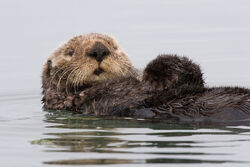| Sea Otter | |
|---|---|
 | |
| Information | |
| Range | North Pacific Ocean |
| Scientific Classification | |
| Kingdom | Animalia |
| Phylum | Chordata |
| Class | Mammalia |
| Order | Carnivora |
| Family | Mustelidae |
| Genus | Enhydra |
| Species | Enhydra lutris |
| Conservation Status | |
 Endangered | |
The Sea Otter is a specie from the Enhydra genus. It is a marine mammal native to the coasts of the northern and eastern North Pacific Ocean.
Appearance
The sea otter is one of the smallest marine mammal species, but is the heaviest known mustelid. Male sea otters usually weigh 22 to 45 kg and are 1.2 to 1.5 m in length, though specimens to 54 kg have been recorded. Females are smaller, weighing 14 to 33 kg and measuring 1.0 to 1.4 m in length. Its baculum is, for the male otter's size, very large, massive and bent upwards, measuring 150 mm in length and 15 mm wideat the base.
Behaviour
The sea otter is diurnal. It has a period of foraging and eating in the morning, starting about an hour before sunrise, then rests or sleeps in mid-day. Foraging resumes for a few hours in the afternoon and subsides before sunset, and a third foraging period may occur around midnight. Females with pups appear to be more inclined to feed at night. Observations of the amount of time a sea otter must spend each day foraging range from 24 to 60%, apparently depending on the availability of food in the area.
Diet
Sea otters consume over 100 different prey species. In most of its range, the sea otter's diet consists almost exclusively of marine invertebrates, including sea urchins, a variety of bivalves such as clams and mussels, abalone, other mollusks, crustaceans, and snails. Its prey ranges in size from tiny limpets and crabs to giant octopuses. Where prey such as sea urchins, clams, and abalone are present in a range of sizes, sea otters tend to select larger items over smaller ones of similar type.
Lifespan
Births occur year-round, with peaks between May and June in northern populations and between January and March in southern populations. Birth usually takes place in the water and typically produces a single pup weighing 1.4 to 2.3 kg. Twins occur in 2% of births; however, usually only one pup survives. At birth, the eyes are open, ten teeth are visible, and the pup has a thick coat of baby fur. Mothers have been observed to lick and fluff a newborn for hours; after grooming, the pup's fur retains so much air, the pup floats like a cork and cannot dive. The fluffy baby fur is replaced by adult fur after about 13 weeks.

